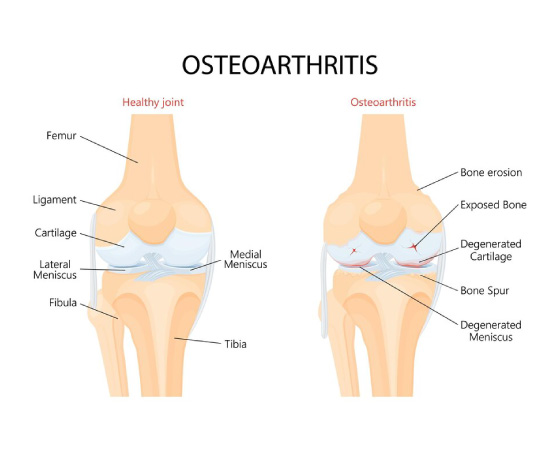Introduction
Osteoarthritis, commonly known as wear-and-tear arthritis, is a prevalent condition in which the natural cushioning between joints, known as cartilage, gradually wears away. This degeneration leads to bones rubbing against each other, causing pain, swelling, stiffness, and reduced mobility. Osteoarthritis of the knee is one of the most common types, affecting millions of people, particularly those over 45 years old. However, young individuals can also experience this condition due to various factors. In this blog, we will delve into the causes, symptoms, diagnosis, and effective non-surgical injection-based treatments for knee osteoarthritis, based on references from published articles.
Causes of Knee Osteoarthritis
The primary cause of knee osteoarthritis is age-related degeneration. As individuals grow older, the cartilage’s ability to heal decreases, leading to its gradual breakdown. However, several risk factors can increase the likelihood of significant arthritis at an earlier age
Weight : Excess weight places extra pressure on the knee joints, accelerating the wear and tear of cartilage. Each pound gained adds 3 to 4 pounds of additional stress on the knees.
Heredity : Genetic mutations or inherited abnormalities in the shape of the bones surrounding the knee joint can make a person more susceptible to knee osteoarthritis.
Gender : Women aged 55 and older have a higher risk of developing knee osteoarthritis compared to men.
Repetitive Stress Injuries : Occupations that involve activities like kneeling, squatting, or lifting heavy weights can put constant pressure on the knee joint, increasing the risk of osteoarthritis.
Athletics : Athletes engaged in high-impact sports like soccer, tennis, or long-distance running may be at higher risk for knee osteoarthritis due to the stress on the knee joints. However, regular moderate exercise can help strengthen joints and reduce the risk of osteoarthritis.
Other Illnesses : Conditions like rheumatoid arthritis and certain metabolic disorders can elevate the risk of knee osteoarthritis.
Symptoms of Knee Osteoarthritis
Knee osteoarthritis can manifest with various symptoms, including :
Pain: Pain increases with activity and improves with rest.
Swelling: The knee may appear swollen and feel tender to touch.
Stiffness: Stiffness is commonly experienced in the morning or after prolonged sitting.
Limited Mobility: Reduced mobility can make it challenging to perform daily activities like walking, climbing stairs, or getting in and out of chairs.
Creaking Sounds: A creaky or crackly sound may be heard when the knee moves.
Diagnosis of Knee Osteoarthritis
A doctor will begin the diagnosis with a physical examination, medical history assessment, and noting any symptoms. Additional tests may include :
X-rays: X-rays can reveal bone and cartilage damage, as well as the presence of bone spurs.
Magnetic Resonance Imaging (MRI) Scans: MRI scans may be ordered when X-rays are inconclusive or suggest other types of joint tissue damage.
Blood Tests: Blood tests help rule out other conditions causing similar symptoms, such as rheumatoid arthritis.
Non-Surgical Injection-Based Treatments
Non-surgical injection-based treatments offer effective management of knee osteoarthritis, reducing pain and promoting healing. AT ALLEVIATE we specialise in the non surgical image guided injection based treatments coupled with a structured multidisciplinary programme for effective rehabilitation. Some of these treatments include :
- Platelet-Rich Plasma (PRP) Injections: PRP injections involve extracting platelets and plasma from the patient’s blood and injecting them into the knee joint. The concentrated mixture contains substances that promote healing.
- Mesenchymal Stem Cells (MSCs): MSCs derived from bone marrow can grow into new tissues, including cartilage. By injecting MSCs into the knee joint, the aim is to stimulate cartilage growth and reduce inflammation.
- Prolotherapy-Prolotherapy or proliferative therapy is a regenerative injection technique which involves multiple small injections of an irritant solution(usually a mex of dextrose and local anaesthetic) at the site of ligament attachments, painful and degenerated tendon insertions and into the joint space in order to promote the growth of normal and healthy cells
- Bone Marrow Aspirate Concentrate: Similar to MSCs, bone marrow aspirate concentrate involves extracting cells from the patient’s body and using them to stimulate the healing process in the knee.
- Autologous Cultured Chondrocytes: This procedure involves collecting cells that form cartilage from the patient’s joints, growing them in a laboratory, and injecting them back into the knee to repair injuries that may lead to osteoarthritis.
Conclusion
Knee osteoarthritis is a prevalent condition, affecting people of various age groups due to age-related degeneration or other risk factors. Non-surgical injection-based treatments offer viable options for managing knee osteoarthritis, reducing pain, and promoting healing without resorting to surgical interventions. However, it’s essential to consult a healthcare professional to determine the most suitable treatment plan based on individual needs and conditions.
References
- National Institute of Arthritis and Musculoskeletal and Skin Diseases. (2020). Handout on Health: Osteoarthritis. National Institutes of Health.
- Hochberg, M. C., Altman, R. D., April, K. T., Benkhalti, M., Guyatt, G., McGowan, J., … & Tugwell, P. (2012). American College of Rheumatology 2012 recommendations for the use of nonpharmacologic and pharmacologic therapies in osteoarthritis of the hand, hip, and knee. Arthritis Care & Research, 64(4), 465-474.
- Bannuru, R. R., Osani, M. C., Vaysbrot, E. E., Arden, N. K., Bennell, K., Bierma-Zeinstra, S. M., … & McAlindon, T. E. (2019). OARSI guidelines for the non-surgical management of knee, hip, and polyarticular osteoarthritis. Osteoarthritis and Cartilage, 27(11), 1578-1589.
- Chatterjee, M., & Fitzsimmons, R. J. (2019). Arthritis and the Aging Population. Current Geriatrics Reports, 8(4), 318-325.





